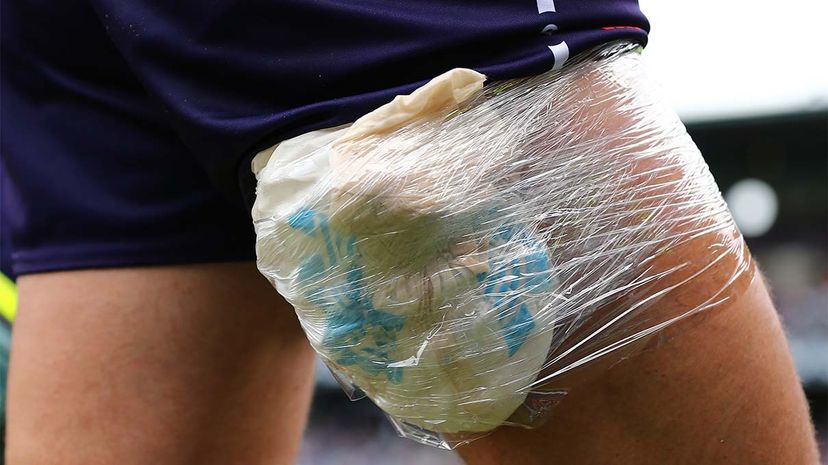 “Aaron Sandilands of the Australian football team the Fremantle Dockers walks to the locker room with an injury to his right hamstring during a July 2, 2017 match in Perth. Paul Kane/Getty Images
“Aaron Sandilands of the Australian football team the Fremantle Dockers walks to the locker room with an injury to his right hamstring during a July 2, 2017 match in Perth. Paul Kane/Getty Images
Most people don’t pay much attention to their hamstrings — those long muscles in the back of the legs. But they should actually be giving their hammies lots of love because the muscles do a lot of important work. And they’re easily injured.
The hamstring is a group of three muscles that runs down the back of the thigh, crossing at the knee joint. It originates at a bony point in the bottom of the pelvis called the ischial tuberosity — or more informally, the "sit bone" — and ends just below the knee at the top of the lower leg. This beefy muscle group works hard to help you extend your leg back and bend your knee. Each hamstring also partners with a hip flexor muscle, located in the front of your pelvis, to help your spine stay flexible and mobile.
Unfortunately, hamstrings often tighten excessively. Tight hamstrings may be the result of an old injury, sitting too long, limited mobility in your back and pelvis, or simply from a natural predisposition to tightness. If your hamstrings become too tight, they may pull and tilt your pelvis, causing back pain. Your tilted pelvis will, in turn, pull on your hamstrings, further tightening them.
A Common Injury
Too-tight hamstrings are also prone to straining or tearing. In fact, hamstring strains are one of the most common muscle strains, along with those in the lower back, shoulder and neck. But hamstring strains and tears aren’t necessarily due to tight hammies.
Many people injure a hamstring while participating in sports such as running, football, soccer or basketball. These sports require sprinting, jumping, and making sudden stops and starts — all motions that can cause a strain or tear. Adolescents are also at risk for hamstring strains during growth spurts if their bones grow faster than their muscles. If this occurs, the muscles are pulled tight, which makes them more susceptible to a tear or strain during sudden movements. Other risk factors for hamstring strains or tears include muscle imbalances, poor conditioning and muscle fatigue.
While hamstring strains are common, they typically heal easily with simple, nonsurgical treatment, namely the popular RICE protocol of rest, ice, compression and elevation. The recovery time can be anywhere from a few weeks to several months. But if you suffer a sudden, traumatic tear, where the hamstring is pulled completely off the bone, that will require surgery and a roughly half-year recovery.
Surgery Replacing RICE Therapy
A rather new development in the world of hamstring injury and health is the recognition of significant partial hamstring tears among older, active people, namely endurance athletes such as marathoners and Ironman participants. Previously, these patients were often diagnosed with tendinitis and treated with little success. Many reluctantly gave up their favorite activities. But thanks in part to better medical imaging, physicians are now able to correctly diagnose overuse hamstring tears, and surgeons are beginning to repair them.
"I’m definitely doing more overuse hamstring surgeries now," says Geoffrey Baer, an orthopedic surgeon with the University of Wisconsin-Madison and team physician for the University of Wisconsin Athletic Department.
As one of a limited number of surgeons currently performing wear-and-tear reattachments, Baer’s patients come from all over the state. But with reports circulating among the medical community about the effectiveness of the surgery — which includes a shorter recovery time than for patients with acute tears — he expects more patients to be diagnosed, and more surgeons to begin performing reattachment surgeries.
Of course, no one wants to undergo surgery, even if there’s a high rate of success. So be kind to your hamstrings.
Stretch them daily to help keep them loose. Use a foam roller to roll them out. Get up from your chair every 30 to 60 minutes. Take long walks. And make sure related muscles, such as the quadriceps, are strong and healthy. Because all of your muscles need to work together, and all of them need to be healthy.
NOW THAT’S INTERESTING
Hamstring strains are especially common in football. According to data from the National Football League Injury Surveillance, NFL players suffer an average of 176 hamstring strains annually. Most injuries (68 percent) occur during noncontact sprinting.





























